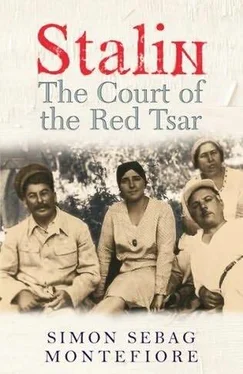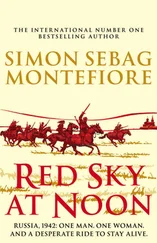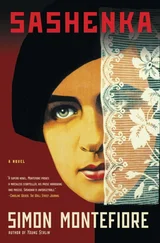29. THE MURDER OF THE WIVES
As the world watched Stalin and Hitler carve up the East, the Vozhd was probing the submission of his comrades by investigating and sometimes killing their wives. His fragile trust in women was irreparably undermined by Nadya’s suicide but this had been exacerbated by his own destruction of the wives of Enemies. As Khrushchev said, he became interested in other men’s wives for the unusual reason that they were possible spies rather than mistresses.
Stalin had always shown a minute interest in the wives. When he received the 1939 census, he ticked the names of some magnates’ wives and children in red pen. The meaning of the ticks was a mystery but it is tempting to regard everything about him as sinister. Maybe he was just working out how many cars the family needed. Wives now sat apart from their husbands at Kremlin dinners. Stalin’s attitude to old favourites, Polina and Dora, had become malicious and suspicious, partly reflecting their relationship with Nadya. But he had always been obsessed with wives knowing too much. As early as 1930, he suggested to Molotov that some comrade’s wife “should be checked… she could not help but know about the outrageous goings-on at their house.” This burning suspicion of uxoriousness partly derived from Stalin’s dislike of anything that interfered with blind devotion to the Party and himself. “Stalin did not recognize personal relations,” said Kaganovich. “The love of one person for another did not exist.” He saw the wives as hostages for his comrades’ good behaviour and punishment for bad: “No one who contradicts Stalin,” Beria told Nina, “keeps his wife.” But the slaughter of wives coincided with Beria’s arrival.
Polina Molotova, the First Lady, was in danger. She was now Commissar of Fishing, a CC candidate member and mistress of her perfume empire. Yet Beria now started investigating her, discovering “vandals” and “saboteurs” secreted in her staff. She had “unknowingly facilitated their espionage.” [157] Polina had an Achilles heel: not only was she Jewish but her brother Karp was a successful businessman in the U.S.A. Indeed, in the mid-thirties, Stalin had even encouraged the U.S. Ambassador Davies to do business in Moscow using Karp, a rare example of his nepotism.
Stalin may have been sending another anti-Semitic signal to Hitler.
On 10 August, when Stalin and Molotov were plotting their diplomatic somersaults, the Politburo indicted Polina. Stalin proposed her expulsion from the Central Committee. Molotov bravely abstained, showing his ability to disagree with Stalin, confidence—and love of Polina. On 24 October, she was relieved of her Commissariat, reprimanded for “levity and hastiness” but declared innocent of “calumnies.” Promoted to run Soviet haberdashery, she returned to her accustomed magnificence: her daughter Svetlana was already notorious as the ultimate Soviet “princess” in her furs and French fashions but the family was constantly watched. [158] Take the case of Molotov’s fitness instructor, a role that reveals a whole new side of the Foreign Commissar. A few months later, Vlasik, who did nothing without Stalin’s knowledge, wrote to Molotov to inform him that Olga Rostovtseva, the fitness lady, was boasting about her closeness to the family: “We know of cases not only where she talks about her sports instruction… but also about your family and apartments…”
Stalin forgot neither Molotov’s defiance nor Polina’s sins, which would return to haunt her. Stalin and Beria had considered kidnapping and murdering her. She was lucky to be alive.
On 25 October 1938, Beria arrested President Kalinin’s wife. In a land where the Head of State’s wife was in prison, no one was safe from the Party. The ineffectual Kalinin, who had not dared resist Stalin since the warnings of 1930 and balletomanic romantic entanglements, though he seethed about his ill treatment, actually lived with another woman, his aristocratic housekeeper, Alexandra Gorchakova. His wife, a snub-nosed Estonian, Ekaterina Ivanovna, set off with a lady friend to arrange an anti-illiteracy campaign in the Far East. When she and this possibly Sapphic lady friend returned to Kalinin’s apartment, they were bugged grumbling about Stalin’s bloodlust. The lady friend was executed, Kalinina sent into exile, like Budyonny’s wife before her. When petitioners asked the President’s help, Kalinin used the same excuse as Stalin himself: “My dear chap, I’m in the same position! I can’t even help my own wife—there’s no way I can help yours!” Not everyone was as lucky as Molotova and Kalinina. 1
In April 1937, Dr. Bronka Poskrebysheva, twenty-seven, pretty wife of the chef de cabinet , rang Stalin and asked to see him alone at Kuntsevo, putting on her best dress, perhaps the polka-dot which appears in all her family photographs. Her husband did not know about this appointment and would have been furious if he had. Vlasik alone knew of this secret meeting. She came to ask for the release of her arrested brother Metalikov, the Kremlin doctor, indirectly related through his wife to Trotsky. After Stalin’s death, Vlasik revealed it to the family and hinted, according to Poskrebyshev and Bronka’s daughter Natalya, that the two started an affair. This is unlikely since Stalin hated women pleading for relatives though one of the tragedies of Soviet life at this time was that women did beg potentates for the lives of their loved ones, offering anything they could, even their bodies. Bronka’s mission failed. [159] In a story that is criss-crossed with emotional distortions, perhaps the strangest cut of all is that Natalya Poskrebysheva, who was born nine months after her mother’s visit to Stalin, believes she may be Stalin’s daughter not only because of Vlasik’s story but also because she once met the daughter of Mikhail Suslov, the ideological boss for most of Brezhnev’s reign, who said: “Everyone knows your real father is lying in the Mausoleum next to Lenin.” This was when Stalin still rested in the Mausoleum. “Do I look like somebody?” Miss Poskrebysheva asked the author. “Like Svetlana Stalin?” It is ironic that she believes her mother’s murderer, Stalin, was her father because she in fact looks the image of Poskrebyshev.
She was terrified of being tarred with the Trotskyite brush.
Before his promotion to Moscow, Beria had groped Bronka at Kuntsevo and she slapped him. “I won’t forget it,” he said. But Bronka did not give up. On 27 April 1939, she called Beria and asked if she could come to discuss her brother. She was never seen again.
Poskrebyshev waited until midnight, then called Beria at home, who revealed that she was in custody but would not discuss it. In the morning, without having slept at all, Poskrebyshev complained to Stalin who said, “It doesn’t depend on me. I can do nothing. Only the NKVD can sort it out,” a line that could not have convinced Poskrebyshev.
Stalin phoned Beria who reminded him of Bronka’s Trotskyite connections. The three met, possibly around midnight on 3 May, when Beria was next in the Little Corner. Beria produced a confession implicating Bronka. Poskrebyshev begged Stalin to release her, using the most un-Bolshevik argument which would have moved anyone but these flinthearts: “What am I to do with my girls? What will happen to them?” and then thinking of his wife’s child by her first marriage: “Will Galia go to an orphanage?”
“Don’t worry, we’ll find you another wife,” Stalin supposedly replied. This was typical Stalin, the man who had threatened Krupskaya that if she did not obey the Party, they would appoint someone else as Lenin’s widow. By the standards of the time, Poskrebyshev made a fuss but he could do no more. After two years, Bronka was shot, aged just thirty-one, as the Germans approached Moscow. [160] Her body was buried in a mass grave near Moscow while her brother is in one of the pits at the Donskoi Cemetery along with many others. Dr. Metalikov’s daughter raised a monument to them in the Novodevichy Cemetery.
Читать дальше
